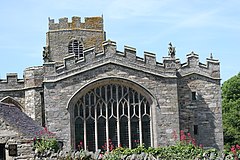Clynnog Fawr
| Clynnog Fawr | |
|---|---|
 St Beuno's Church, Clynnog Fawr |
|
| Clynnog Fawr shown within Gwynedd | |
| Population | 997 (2011) |
| OS grid reference | SH414496 |
| Community | |
| Principal area | |
| Country | Wales |
| Sovereign state | United Kingdom |
| Post town | CAERNARFON |
| Postcode district | LL54 |
| Dialling code | 01286 |
| Police | North Wales |
| Fire | North Wales |
| Ambulance | Welsh |
| EU Parliament | Wales |
| UK Parliament | |
| Welsh Assembly | |
Clynnog Fawr, often simply called "Clynnog", is a village on the north coast of the Llŷn Peninsula in Gwynedd, north-west Wales.
Clynnog Fawr lies on the A499 road between Caernarfon and Pwllheli, at grid reference SH415500. It had a population of 130 in 1991, which had increased to 997 at the 2011 Census. The community covers an area of 4,551 hectares (17.57 sq mi). The main feature of the village is the parish church, dedicated to Saint Beuno, which is much larger than would be expected in a village of Clynnog's size. The site is said to be that of a Celtic monastery founded by Beuno in the early 7th century. Clynnog means 'the place of the holly-trees' [compare Breton Quelneuc (Kelenneg), Gaelic Cuilneach]. It developed into an important foundation and some Welsh law manuscripts specify that the Abbot of Clynnog was entitled to a seat at the court of the king of Gwynedd.
The church is recorded as being burnt in 978 by the Vikings and later burnt again by the Normans. By the end of the 15th century it was a collegiate church, one of only six in Wales. The church was an important stopping place for pilgrims heading for Bardsey Island and contains Cyff Beuno, an ancient wooden chest hollowed out of a single piece of ash and used to keep alms donated by those on pilgrimages. Maen Beuno or "Beuno's Stone" has markings reputed to be those of Beuno's fingers. Outside in the churchyard there is a canonical sundial dated between the late 10th century and the early 12th century. Ffynnon Beuno (St Beuno's Well) is a grade II* listed structure at the south-west end of the village.
...
Wikipedia

